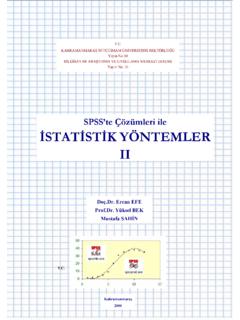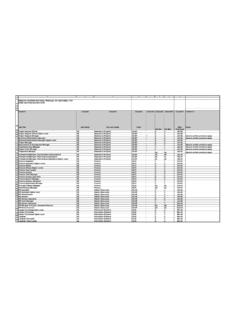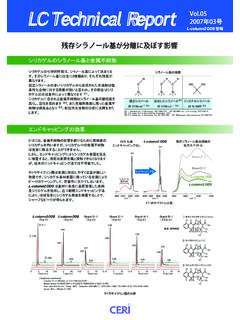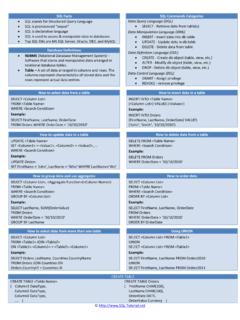Transcription of Displaying Data from Multiple Tables - Başkent …
1 1 Displaying data from Multiple Tables 2 Objectives After completing this lesson, you should be able to do the following: Write SELECT statements to access data from more than one table using eguality and nonequality joins View data that generally does not meet a join condition by using outer joins Join a table to itself Lesson Aim This lesson covers how to obtain data from more than one table , using the different methods available. 3 Obtaining data from Multiple Tables SELECT , , FROM emp e, dept d WHERE = ; data from Multiple Tables Sometimes you need to use data from more than one table .
2 In the slide example, the report displays data from two separate Tables . EMPNO exists in the EMP table DEPTNO exists in both the EMP and DEPT the Tables . LOC exists in the DEPT table . To prod ce the report. you need to link EMP and DEPT Tables and access data from both of them. 4 Cartesian Product A Cartesian product is formed when: A join condition is omitted A join condition is invalid All rows in the first table are joined to all rows in the second table To avoid a Cartesian product, always include a valid join condition in a WHERE clause.
3 5 Generating a Cartesian Product SELECT ename, dname FROM emp, dept; ENAME DNAME BLAKE ACCOUNTING SMITH ACCOUNTING ALLEN ACCOUNTING 56 Rows Selected 6 What Is a Join? Use a join to query data from more than one table . SELECT , table2. column2 FROM table1, table2 WHERE tablel. columnl = table2. column2 ; Write the join condition in the WHERE clause. Prefix the column name with the table name when the same column name appears in more than one table . Defining Joins When data from more than one table in the database is required, a join condition is used.
4 Rows in one table can be joined to rows in another table according to common values existing in corresponding columns, that is, usually primary and foreign key columns. TO display data from two or more related Tables , write a simple join condition in the WHERE clause, in the syntax: denotes the table and column from which data is retrieved Table1. column1 = is the condition that joins (or relates) the Tables together table2. column2 7 Types of Joins Equijoin Non-equijoin Outer join Self join 8 Types of Joins There are wo main types of join conditions: Equijoins NonAequijoins Additional join methods include the following Outerjoins Selfjoins Set Operators Note: Set operators are not covered in this course.
5 They are covered in another SQL course. 9 What Is an Equijoin? Equijoins To determine the name of an employee s department, you compare the value in the DEPTNO column in the EMP table with the DEPTNO values in the DEPT table . The relationship between the EMP and DEPT table is an equijoin A that is, values in the DEPTNO column on both Tables must be equal. Frequently, this type of join involves primary and foreign key complements. Note: Equijoins are also called simple joins or innerjoins. 10 Retrieving Records with Equijoins SELECT , , , , FROM EMP, DEPT WHERE = EMPNO ENAME DEPTNO DEPTNO LOC 7698 BLAKE 30 30 CHICAGO 7369 SMITH 20 20 DALLAS 7499 ALLEN 30 30 CHICAGO 14 rows selected.
6 Retrieving Records with Equijoins in the slide examaple. The SELECT clause specifies the column names to retrieve: A employee name, employee number, and department number, which are columns in the emp table A department number, department name, and location, which are columns in the DEPT table . The FROM clause specifies the two Tables that the database must access: EMP table DEPT table The WHERE clause specifies how the Tables are to be joined: 11 Oualifying Ambiguous Column Names Use table prefixes to qualify column names that are in Multiple Tables .
7 Improve performance by using table prefixes. Distinguish columns that have identical names but reside in different Tables by using column aliases. Qualifying Ambiguous Column Names You need to gualify the names of the columns in the WHERE clause ""itli the table names to avoid ambiguity without the table prefixes. the DEPTNO column could be from either the DEPT table or the EMP table . It is necessary to add the table prefix to execute your query. If there are no common column names between the two Tables , there is no need to qualify the columns.
8 Howevwr, you will gain improved performance by using the table prefix because you tell the Oracle Server exactly where to find the columns. 12 Using table Aliases The following two scripts are equivalent. In the second one table aliases are used. SELECT , , , , FROM emp, dept WHERE = ; SELECT , , , , FROM emp e, dept d WHERE = ; EMPNO ENAME DEPTNO DEPTNO LOC 7698 BLAKE 30 30 CHICAGO 7369 SMITH 20 20 DALLAS 7499 ALLEN 30 30 CHICAGO 14 rows selected. 13 EQUIJOIN SELECT , , , , FROM EMP, DEPT WHERE = ; EMPNO ENAME DEPTNO DEPTNO LOC 7698 BLAKE 30 30 CHICAGO 7369 SMITH 20 20 DALLAS 14 rows selected.
9 SELECT , , FROM emp e , dept d WHERE = ; ENAME DEPTNO DNAME BLAKE 30 SALES SMITH 20 RESEARCH 14 rows selected. 14 Additional Search Conditions Using the AND Operator Additional Search Conditions In addition to the join, you may have criteria for your WHERE clause. For example, to display King's employee number, name, department number, and departments localion, you need an additional condition in the WHERE clause. SELECT , , , , FROM EMP, DEPT WHERE = AND INITCAP(ename) = 'King' ; EMPNO ENAME DEPTNO DEPTNO LOC 7839 KING 10 10 NEW YORK SELECT , , FROM EMP e, SALGRADE s WHERE BETWEEN AND ; ENAME SAL GRADE SMITH 800 1 JAMES 950 1 14 rows selected.
10 15 Joining More Than Two Tables SELECT , , , FROM EMP e, DEPT d, salgrade s WHERE = AND BETWEEN AND hisal; ENAME DEPTNO DNAME GRADE KING 10 ACCOUNTING 5 CLARK 10 ACCOUNTING 4 MILLER 10 ACCOUNTING 2 FORD 20 RESEARCH 4 SCOTT 20 RESEARCH 4 JONES 20 RESEARCH 4 ADAMS 20 RESEARCH 1 SMITH 20 RESEARCH 1 BLAKE 30 SALES 4 ALLEN 30 SALES 3 TURNER 30 SALES 3 MARTIN 30 SALES 2 WARD 30 SALES 2 JAMES 30 SALES 1 14 rows selected. 16 Non-Equijoins The relationship between the EMP table and the SALGRADE table is a nonAequijoin, meaning that no column in the EMP table corresponds directly to a column in the SALGRADE table .















